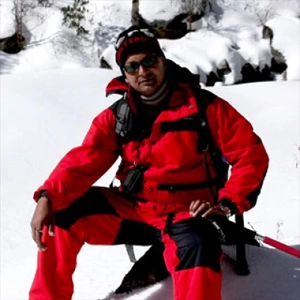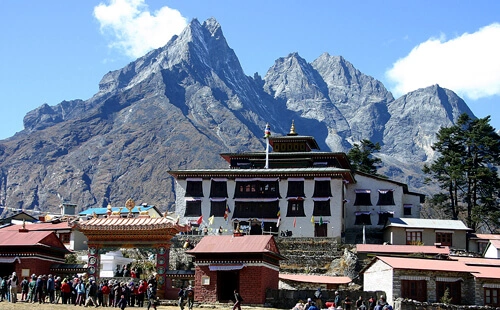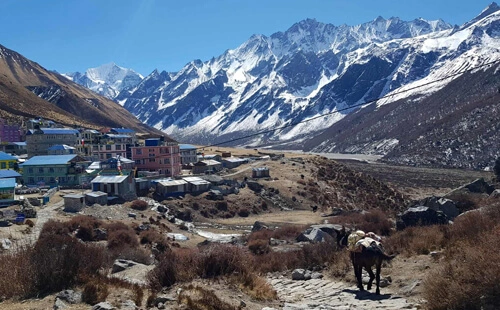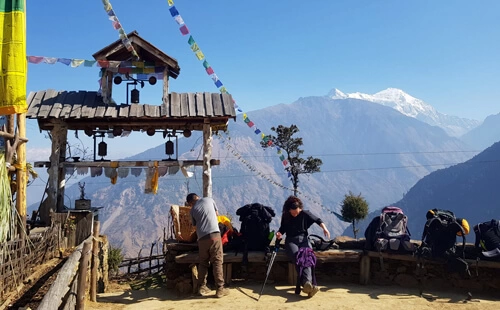Annapurna Circuit Trekking cost for TIMS Card and other permit fees
As the odyssey to the Annapurna Circuit takes place in one of the conservation areas of the country, the Annapurna Conservation Area, you will have to at least obtain two of the permits called the Trekkers Information and Management System (TIMS) Card and the Annapurna Conservation Area Permit (ACAP).
The TIMS card is mandatory for all trekkers in Nepal, whether they are traversing the Langtang Trekking region, Manaslu, or Kanchenjunga, which costs NPR 2,000 per person per entry, approximately USD 20 and can be obtained online or upon arrival in Kathmandu and Pokhara from the Nepal Tourism Board (NTB), the Trekking Agencies Association of Nepal(TAAN), or any trustworthy locally based trekking agencies, operators, or organizers.
While the ACAP permit grants you access specifically into the Annapurna Conservation Area, which encompasses the Annapurna Circuit Trekking, whose fee is NPR 3,000 (around USD 30) per trekker for all the tourists across the globe, travelers from the SAARC (South Asian Association for Regional Cooperation) countries can get this ACAP at a reduced price of NPR 1,000 (around USD 10), which particularly does not face any fluctuation based on trekking off or on season, unlike the off-beaten Himalayan expedition to the Upper Mustang Valley and the Manaslu Circuit Trek requiring a special restricted permit.
These permit costs do add to the overall budget to embrace your inner explorer on the way to the Annapurna Circuit Trek so make sure you get your hand on these mandatory permits before you officially begin the embarking and do not have to encounter any legal issues for a seamlessly trekking experience.
What determines the Annapurna Circuit Trek cost of transportation?
Depending on the trekkers, hikers, and travelers' choice of mode of transportation, including the condition of the trekking trail, trip style, and the number of people they’re hiking with, the cost for transportation will vary. For instance, on an overland voyage to the Annapurna Circuit, local buses are cheaper in comparison to private vehicles or domestic flights, which commonly take longer to reach destinations but come with an immensely local experience that connects you to the true essence of the Annapurna Himalayas and its people.
Here’s a small breakdown of the typical transportation costs for the Annapurna Circuit Trek:
Local Bus: The local tourist bus from Kathmandu to Besishar is the most budget-friendly transportation option to begin the journey to the Annapurna Circuit, which can cost NPR 800 to NPR 1,200 (USD 7 to USD 11) for a one-way ride that can take anywhere from 6 to 8 hours.
Jeep: If you are a larger trek group to the Annapurna Circuit and prefer a more comfortable ride for short stretches, especially on arrival or departure days, hiring a private jeep is a must and is particularly common on the route from Beisahar towards Manang, a lower altitude section of the Annapurna Circuit Odyssey, whose cost can also vary based on the distance covered, negotiation skills, and number of people sharing the ride, which usually costs between USD 110 (Kathmandu to Besishar) and USD 120 (Pokhara to Kathmandu) for a one-way trip.
Domestic Flight: It is the best choice for trekkers with a limited number of stays in Nepal looking forward to saving time and still wanting to conquer the Annapurna Circuit or looking for a more luxurious experience at the starting and ending days of the journey, which costs around USD 125 from Jomsom to Pokhara and is generally approximately USD 100 from Pokhara to Kathmandu and vice versa for a one-time flight.
As transportation is also an integral part of the overall budget for the Annapurna Circuit Trek, by understanding these transportation options and their costs for 2024 and 2025, you can plan better to traverse the Annapurna Trekking region.
Accommodation, Foods, and Drinks cost on the way to the Annapurna Circuit
Along the trekking route to the Annapurna Circuit, trekkers, travelers, or visitors can find basic tea houses as accommodation that can cost you around USD 5 to USD 15 per night based on location and amenities excluded or included. These teahouses on the way to Annapurna Circuit also provide daily meals, including breakfast, which costs USD 5-7, lunch, and dinner, usually around USD 7-10 per meal.
Hence, Dal Bhat is the most filling and affordable lunch and dinner option, while you also get to refill lukewarm drinking water at various stopping places along with tea, coffee, hot chocolate, soft and cold drinks, juice, and alcoholic products such as beer and local spirits that may cost USD 1-4 per cup, USD 2-4 per bottle or can, and USD 4–7 per bottle.
Although bottled water is also available throughout the journey to the Annapurna Circuit, getting refilled is a cost-effective and healthy choice, and alcohols are usually not recommended in the high-altitude Himalayan areas to prevent acute mountain or altitude sickness. As compared to Kathmandu and the lower-altitude region of the Annapurna Circuit, higher-altitude teahouses tend to be slightly more expensive due to the difficulty of getting supplies that usually have to be carried by mules or porters.
Guides and Porter Cost for trekking to the Annapurna Circuit
Like trekking to any other protected national park or conservation area, the Annapurna Circuit Trek also falls into the Annapurna Conservation Area, where solo traversing is allowed only by hiring one of the reliable and trustworthy government-licensed guides. Usually, the guide charges you USD 30-35 per day, while the porter charges you USD 20–25 per day, which includes their daily salary, expenses for meals, accommodation, and transport as well.
Whether you are hopeful for a solo voyage to the Annapurna Circuit or a group trip, hiring professionals is crucial for better and safer navigation of the route you might have never encountered before, local culture insights, safety, and logistical management, assistance with permits, accommodation, and heavy backpacks.
While we say so, it is important to understand that the sole purpose of a guide is to lead the route, and that of a porter is to carry loads whose limit is within 20–25 in combined, and one porter can be shared between two trekkers and guides, and porters gratitudes are highly appreciated for their diligent effort and top level of service.
How much extra do you have to pay for charging, wifi, and a hot shower during the Annapurna Circuit Trek?
Despite the popularity of the Annapurna Circuit, it is still a high Himalayan expedition in comparatively rural areas where the availability of electricity, unlike in the well-developed cities of Nepal such as Kathmandu and Pokhara, is not guaranteed at all times, more specifically in remote areas, and hence comes at an extra pay of USD 1 to USD 2 per device per hour. As you ascend to higher altitudes, the cost of charging electric devices can also increase due to the region’s reliance on mostly solar power.
It goes similar for the wifi facilities on the way to the Annapurna Circuit. Normally, tea houses offer WiFi, typically charging USD 3 to USD 4 for limited data and time, whose speed and reliability can be spotty; hence, consider purchasing a local SIM card such as NTC or Ncell with a data plan in Kathmandu or Pokhara for better connectivity throughout the journey determined by the network convergence in the region, which also tends to fluctuate time and again.
As per hot showers, it is a luxury on the trek to the Annapurna Circuit that also comes at a price usually USD 2 to USD 5 per shower depending upon the teahouse and altitude, and all of these come under the miscellaneous expenses that also show a major impact in the overall package cost to the circuit of the tenth largest mountain grandeur on the earth, Mt. Annapurna (8,091 m).
What is the cost of hiking gear and equipment for pilgrimage to the Annapurna Circuit?
Yes, you have guessed it right! Like any other expenditure for the Annapurna Circuit trek, the cost of trekking gear and equipment can also vary greatly depending on whether you choose to rent, buy new items, or borrow from your friends, as well as the quality of the gear. It is important to note that the right gear and equipment are key to a safe and comfortable Himalayan journey.
Nonetheless, here is a breakdown of the cost of some necessary trek gear and equipment and their estimated cost for voyaging the Annapurna Circuit in 2024 and 2025:
- Trekking boots: Waterproof comfortable hiking boots can range from USD 100 to USD 200 or more and are generally rentable.
- Backpack: A 40-50 liter good size perfectly fitting for the Annapurna Circuit Trek can cost USD 50-150.
- Sleeping bag: A good quality sleeping bag is essential for highly elevated areas such as Thorong La Pass which can range from USD 100 to USD 300+.
- Trekking poles: It is best to keep your balance and stability in steep ascents and descents that can cost USD 30 to USD 100+.
- Thermal clothing: Base Layer, mid layer, and out layer along with waterproof and windproof jacket that can cost USD 200-550.
- Accessories: USD 90-260
To conclude, the cost of hiking gear and equipment to trek the Annapurna Circuit can vary widely depending on your choice. Budgeting USD 5,000 to USD 1,000 for new gear should be reasonable for 2024 and 2025 while renting and borrowing can reduce the overall cost significantly.
Is travel insurance an expensive addition to the Annapurna Circuit Trek Cost?
At a glance, the travel insurance for the Annapurna Circuit can seem expensive but is an in-value investment having to consider the trek’s remote location, high altitudes, and potential risks involved in providing coverage for medical emergencies, evacuation, trip cancellations, and other unforeseen circumstances.
In general, low-budget travel insurance can cost you between USD 50 and 100 for basic coverage, USD 100 and 150 for comprehensive coverage in the mid-range, and more than USD 150 for high-budget travel insurance that covers higher limits and additional benefits for visiting the Annapurna Circuit for unforgettable holidays in 2024 and 2025.
Although it is not mandatory to purchase travel insurance and is an additional cost, it is a wise investment that ensures trekkers, travelers, and climbers peace of mind and financial protection, along with necessary aid in case of emergencies and unforeseen events.
Normally, the trekking package cost for the Annapurna Circuit crafted by any trustworthy travel, trek, and tour company covers most of the essential expenses of the trek, including food, accommodation, permits, and travel insurance for all the hardworking Nepalese staff, such as guides and porters, used during the trek, along with their meals, accommodation, and any sort of transportation involved en route that comes under the itinerary.
Moreover, in general, these travel and trekking agencies and companies also facilitate the renting of the best quality trekking gear and equipment, such as trekking poles, sleeping bags, crampons, ropes, etc., if required, followed by a complimentary dinner before and after the end of the tour to the Annapurna Circuit and free pick-up and drop-off at the Tribhuvan International Airport (TIA). Even if you are tight on budget, they make sure you get the best out of what you can afford, with no compromise in service or overall experience.
Therefore, the Annapurna Circuit Trekking cost for 2024 and 2025 can vary anywhere from USD 1,000 to USD 2,000 or more, depending on your budget plan, individual preferences, and circumstances. It can also be a hassle for trekkers to manage the crucial logistics, so buying a package from any trustworthy trekking company and agency is the best option for a more budget-friendly and wholesome experience and can significantly reduce costs.
Some Useful Information
Is it possible for students to get a discount on the trekking to the Annapurna Circuit?
Yes, several travel and trekking agencies based locally in Kathmandu and different parts of the country do offer a special group discounted price for students seeking a memorable trip to the Annapurna Circuit for any purpose, be it research, entertainment, or educational, catering to all budget-conscious students while fostering a sense of teamwork and cultural and natural appreciation.
Usually, the local Sherpa guides from the Himalayas accompany the tour to the Annapurna Circuit, extremely knowledgeable not just in the trekking route but also in cultural, historical, and natural aspects of the region, which can be a great helping hand in enriching the student’s learning experience while they also ensure your safety and well-being in the high-altitude training in first aid and trek to the higher Himalayas.
Is mountain biking on the Annapurna Circuit more expensive than trekking?
Yes, in comparison to mountain biking on the Annapurna Circuit, trekking can be less expensive due to the lower cost of gear and potentially fewer logistical challenges, while mountain biking incurs higher costs, primarily due to the need for biking equipment and specialized support.
Plenty of highly experienced travel, trek, and tour operators in Nepal do offer an adventurous and thrilling alternative to traditional trekking for mountain biking enthusiasts, allowing trekkers and travelers to cover the scenic trail through the unique and diverse Himalayan landscape and terrain through massive, massive snow-capped peaks and deep river valleys.
We at Adventure Himalayan Travels and Treks also offer the Annapurna Circuit Moutain Biking for 14 days and the 10 Days Half Annapurna Circuit Mountain Biking, which can cost from USD 1,775 to USD 2,075 and from USD 1,375 to USD 1,575.
Why save slightly more for a yoga trip to the Annapurna Circuit?
Much to the delight of yoga lovers, the Annapurna Circuit Itinerary can be customized in such a way that you get to relish the mental and spiritual benefits that may additionally add around USD 30–50 per day to the salary of a yoga instructor, but it is worth the effort to lose yourself in the immense spiritual energy of serene snow-capped peaks and hills in the ultimate tranquillity of the majestic Himalayas.
A yoga session each day by a certified yoga instructor on the way to the Annapurna Circuit makes the whole journey a holistic and enriching adventure and definitely one of the best ways to actually initiate a true connection to the real essence of the Annapurna Himalayas, as the land itself is widely revered by the locals themselves as the area protected by the Hindu goddess of grain and prosperity, "Annapurna.”.
What if you want to upgrade the level of services en route to the Annapurna Circuit?
While upgrading the level of service en route to the Annapurna Circuit is possible, although it can get limited after reaching a significant altitude and can significantly enhance your overall experience, it can also add massively to the overall trekking cost.
You can always opt for higher-end lodges and tea houses offering better facilities such as private rooms, hot showers, wifi, and an international food menu, and change the mode of transportation during the starting and ending trek days from four-wheelers to airlifts at some additional cost, which are usually out of the itinerary and are arranged for you in your special request.
Get up to 10% discount on off the season traverse to the magical land of the Himalayas in the Annapurna Circuit
Usually, the winter and summer months from December to March and June to August are considered off-season for trekking in Nepal. However, by being prepared adequately, acclimating well to the high altitude in what could be an arduous environment, and packing appropriately, the Annapurna Circuit Trekking is an ideal Himalayan adventure throughout the year. If you choose us to traverse the trail from December to March and June to August, you can get up to 10% off.
The offer might be valid for a limited time, letting you experience the greatest of the Himalayas, including the New Year and Christmas Eve. Check out the top 6 best trekking destinations for these holidays in 2024 and 2025 in Nepal to save money and, at the same time, create memories for a lifetime at the most reasonable and affordable package cost.
Never like before Annapurna Circuit Discounted Trek for Children age below 8 years old
Hurray! Children below the age of 8 can get up to a 10% discount on the Annapurna Circuit Trek, whose standard package price per person is USD 1,150 per person. Hence, if you are a family person looking forward to completing the Annapurna Circuit expedition in 2024 and 2025, it could be the best trekking trail for you to aid in bonding with your family members, including kids above 5 years old, in the Nepalese Himalayas to create and cherish each moment.
Several trekking and traveling local agencies, like Adventure Himalayan Travels and Treks, excel at carefully crafting the journey to the Annapurna Circuit Trek for anyone with a recommendable level of physical fitness and mental determination, including children below 8 years old, putting careful consideration into their safety, engagement, and comfort.




